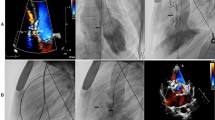Abstract
Transfemoral device occlusion and minimally invasive surgical repair are performed for doubly committed subarterial ventricular septal defect (dcVSD) to reduce the invasiveness of the conventional surgical repair through a median sternotomy. However, few studies have compared them in terms of effectiveness and cost. Inpatients with isolated dcVSD who had undergone transfemoral device occlusion or minimally invasive surgical repair from January 2011 to June 2014 were reviewed for a comparative investigation between the two procedures. Procedure success was achieved in 36 transfemoral (75 %) and in 36 surgical (100 %) procedures (p = 0.001). Transfemoral patients were older, with a VSD size similar to that of surgical patients (14.5 ± 11.7 vs 4.4 ± 2.9 years, p < 0.001; 4.5 ± 1.5 vs 4.4 ± 1.3 mm, p = 0.577, respectively). No significant difference was observed in complication rates between the two treatment groups (p = 1). No large residual shunt was observed. Small residual shunt was noted in two transfemoral patients and four surgical patients (p = 0.674). All these small residual shunts closed spontaneously during follow-up. The surgical repair costs 26 % less than the device occlusion (Yuan 22063.2 ± 343.9 vs Yuan 29970.1 ± 1335.2, p < 0.001), where most of the cost was attributed to the occluder in the amount of Yuan 19,500. Compared with device occlusion, minimally invasive surgical repair can provide superior efficacy and comparable complication rates. In addition, it is 26 % cheaper than device occlusion. In low-income countries where healthcare resources are limited, medical resources must be judiciously allocated to the treatment that allows for effective treatment of the largest number of patients.



Similar content being viewed by others
References
Bonhoeffer P, Fabbrocini M, Lecompte Y et al (1992) Infundibular septal defect with severe aortic regurgitation: a new surgical approach. Ann Thorac Surg 53:851–853
Chauvaud S, Serraf A, Mihaileanu S et al (1990) Ventricular septal defect associated with aortic valve incompetence: results of two surgical managements. Ann Thorac Surg 49:875–880
Chen Z, Chen L, Wu L (2009) Transcatheter amplatzer occlusion and surgical closure of patent ductus arteriosus: comparison of effectiveness and costs in a low-income country. Pediatr Cardiol 30:781–785
Chen ZY, Lin BR, Chen WH et al (2014) Percutaneous device occlusion and minimally invasive surgical repair for perimembranous ventricular septal defect. Ann Thorac Surg 97:1400–1406
Gu M, You X, Zhao X, Zheng X, Qin YW (2011) Transcatheter device closure of intracristal ventricular septal defects. Am J Cardiol 107:110–113
Hijazi ZM, Hakim F, Haweleh AA et al (2002) Catheter closure of perimembranous ventricular septal defects using the new Amplatzer membranous VSD occluder: initial clinical experience. Catheter Cardiovasc Interv 56:508–515
Hoffman JI, Kaplan S (2002) The incidence of congenital heart disease. J Am Coll Cardiol 39:1890–1900
Jung SH, Gon Je H, Choo SJ et al (2010) Right or left anterolateral minithoracotomy for repair of congenital ventricular septal defects in adult patients. Interact CardioVasc Thorac Surg 10:22–26
Leon-Wyss J, Vida VL, Veras O et al (2005) Modified extrapleural ligation of patent ductus arteriosus: a convenient surgical approach in a developing country. Ann Thorac Surg 79:632–635
Li J, Liu Y, Yu C et al (2008) Comparison of incisions and outcomes for closure of ventricular septal defects. Ann Thorac Surg 85:199–203
Liu YL, Zhang HJ, Sun HS et al (2000) Repair of cardiac defects through a shorter right lateral thoracotomy in children. Ann Thorac Surg 70:738–741
Mishaly D, Ghosh P, Preisman S (2008) Minimally invasive congenital cardiac surgery through right anterior minithoracotomy approach. Ann Thorac Surg 85:831–835
Nicholson IA, Bichell DP, Bacha EA et al (2001) Minimal sternotomy approach for congenital heart operations. Ann Thorac Surg 71:469–472
Qin Y, Chen J, Zhao X et al (2008) Transcatheter closure of perimembranous ventricular septal defect using a modified double-disk occluder. Am J Cardiol 101:1781–1786
Rein JG, Freed MD, Norwood WI, Castaneda AR (1977) Early and late results of closure of ventricular septal defect in infancy. Ann Thorac Surg 24:19–27
Sim EK, Grignani RT, Wong ML, Quek SC, Wong JC et al (1999) Outcome of surgical closure of doubly committed subarterial ventricular septal defect. Ann Thorac Surg 67:736–738
van de Wal HJ, Barbero-Marcial M, Hulin S et al (1998) Cardiac surgery by transxiphoid approach without sternotomy. Eur J Cardiothorac Surg 13:551–554
Vida VL, Barnoya J, O’Connell M et al (2006) Surgical versus percutaneous occlusion of ostium secundum atrial septal defects: results and cost-effective considerations in a low-income country. J Am Coll Cardiol 47:326–331
Wang Q, Li Q, Zhang J et al (2010) Ventricular septal defects closure using a minimal right vertical infraaxillary thoracotomy: seven-year experience in 274 patients. Ann Thorac Surg 89:552–555
Yang J, Yang L, Wan Y et al (2010) Transcatheter device closure of perimembranous ventricular septal defects: mid-term outcomes. Eur Heart J 31:2238–2245
Zhou D, Pan W, Guan L (2012) Transcatheter closure of perimembranous and intracristal ventricular septal defects with the SHSMA occlude. Catheter Cardiovasc Interv 79:666–674
Conflict of interest
The authors declare that they have no conflict of interest.
Author information
Authors and Affiliations
Corresponding author
Additional information
Zhao Yang Chen, Yuan Ji Ma, and Wen Zhi Pan contributed equally to this article.
Rights and permissions
About this article
Cite this article
Chen, Z.Y., Ma, Y.J., Pan, W.Z. et al. Transfemoral Device Occlusion and Minimally Invasive Surgical Repair for Doubly Committed Subarterial Ventricular Septal Defects. Pediatr Cardiol 36, 1624–1629 (2015). https://doi.org/10.1007/s00246-015-1207-4
Received:
Accepted:
Published:
Issue Date:
DOI: https://doi.org/10.1007/s00246-015-1207-4




